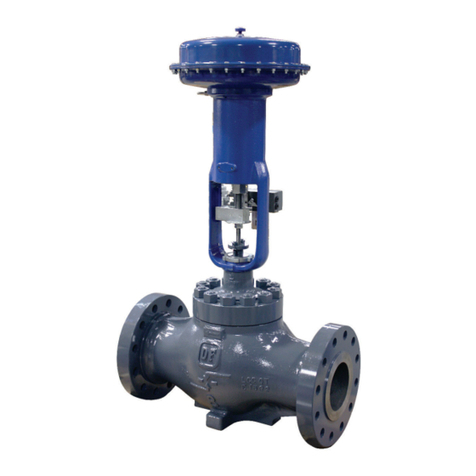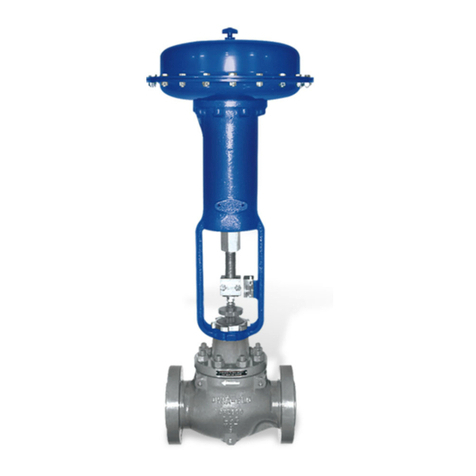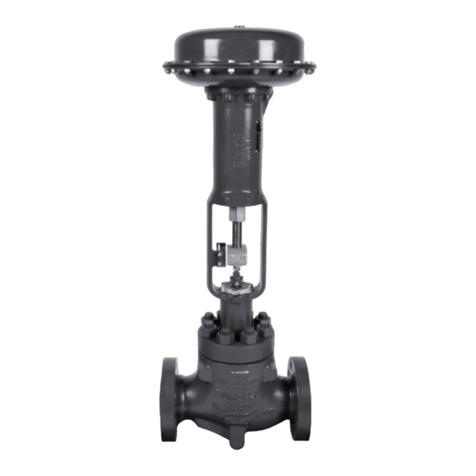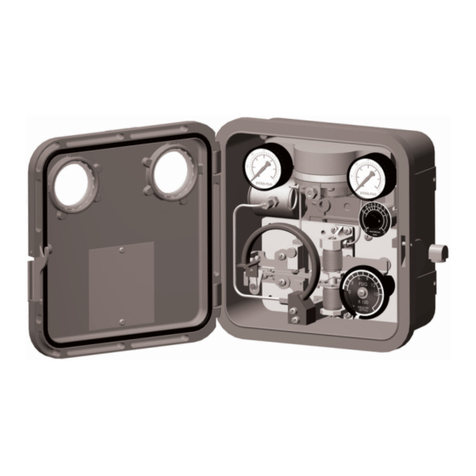
Dyna-Flo Control Valve Services Ltd.
Phone: 780 •469 •4000 Toll Free: 1 •866 •396 •2356 Fax: 780 •469 •4035 Website: www.dynaflo.com
Model 570, 571, 573 Control Valve
P-570M1217B 10
Operation, Parts, and Instruction Manual
DISASSEMBLY (Continued)
3Secure the valve and actuator assembly and remove them
from the pipeline by removing the flange studs (Key 32).
Valve / Actuator Disassembly
1Replacing the ball seal can be accomplished without
removing the actuator. Place the valve assembly on a
flat work surface that can support the assembly
weight, the valve seal protector ring (Key 10) should
be facing up. Relieve any actuator spring preload and
refer to the appropriate actuator instruction manual
for actuator disassembly instructions.
2Take note of the ball position relative to the
actuator lever where the spline of the shaft goes
through. This will assure proper ball position during
reassembly. A digital camera works well for this. You
can remove the travel indicator arrow, (DFR 026 and
DFR 047) or the cover plate, (DFR 070, DFR 156 and
DFR 220) from the actuator and mark the shaft and
lever with a punch or take a digital picture showing
the ball position and the lever position. For Dyna-Flo
Model DFR 026 actuators there is no clamp on the
lever. For the DFR 047, DFR 070, DFR 156 and the DFR
220 you will have to remove the cover and loosen the
clamp on the lever.
3Remove the actuator mounting bolt (Key 30) and slide
the valve body assembly from the actuator. This may
require the use of a pry bar between the body and the
actuator mounting pad. The lever on the DFR 070, DFR
156 and DFR 220 will sometimes bind when trying to
remove the valve body assembly. A wedge driven into
the slot in the lever will help to loosen the clamp on
the lever. CAUTION: Using a hammer to drive the
actuator off of the valve shaft can seriously damage
the valve.
WARNING
To Avoid personal injury and property damage
use caution when separating the actuator from
the valve body, during removal the valve ball
may rotate in the body.
Packing Removal
For live loaded packing, refer to the Live Loaded Packing
instruction manual (P-LLPR) for assembly instructions.
1Remove the packing nuts (Key 27), note any corrosion
or roughness in the threads. Remove the packing
follower (Key 23) by sliding it over the drive shaft
(Key 16).
NOTE
Valve shaft packing (Key 22) may be removed
without removing the drive shaft (Key 16) from
the valve however it is easier to remove the
packing and inspect the valve shaft and packing
bore when the drive shaft is removed. Refer to
Ball / Shaft Removal for drive shaft disassembly
instructions.
2Using a mechanics pick set or wire hook, remove the
packing box parts (Keys 21 & 22) from the packing
bore. Be extremely cautious not to damage the drive
shaft or the packing bore while removing packing as
this will cause new packing to leak.
3Inspect all packing parts, drive shaft, and packing bore
for damage, polish or replace as necessary. Refer to
Assembly / Packing for packing assembly instructions.
Ball Seal Removal
NOTE
During seal removal, the valve actuator may
remain mounted to the valve body.
1Rotate the valve ball (Key 3) to the open position.
For PTFE Composition Ball Seals
ARemove the seal protector ring screws (Key 12 &
12A) and seal protector clips (Key 11 & 11A).
Carefully remove the seal protector ring (Key 10)
and gasket (Key 9).
BRemove the seal (Key 5) from the valve body.
For 1, 1-1/2, & 2 inch valves remove the back-up
ring (Key 4) as well.
CClean and inspect all seating, sealing, and gasket
surfaces for damage. If there is excessive wear
or damage to the seal ring, check the valve ball
(Key 3) for damage in corresponding areas. It is
also a good opportunity to inspect the flange
gasket surfaces for damage while the valve is
out of line.



































